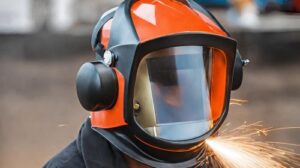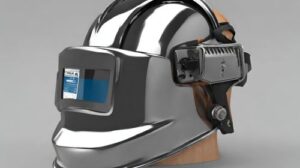Table of Contents
- Unraveling the Mysteries: What is a Good Welding Helmet?
- Top Brands in Welding Helmets
- How to Care for Your Welding Helmet
- Conclusion
- FAQs: Decoding the Burning Questions
- What are the differences between passive and auto-darkening welding helmets?
- Do welding helmets come with adjustable settings for sensitivity and delay?
- Are all welding helmets suitable for all types of welding processes?
- How do I know if my welding helmet meets safety standards?
- What is the average lifespan of a welding helmet?
Are you stepping into the world of welding and puzzled about what is a good welding helmet? Well, fear not, fellow welder! Whether you’re a seasoned pro or just starting, finding the right welding helmet is crucial for your safety and comfort.
But with many options flooding the market, how do you distinguish the good from the great? Fear not! We’re here to unravel the mystery and guide you through the maze of welding helmets to help you find the perfect fit for your welding adventures.
Unraveling the Mysteries: What is a Good Welding Helmet?
Understanding the Basics
First, let’s break down the fundamentals of what makes a welding helmet stand out from the rest!
- Optical Clarity: A good welding helmet should provide crystal-clear visibility when in action, ensuring you can see every weld with precision.
- Comfort: Long-hour welding demands a helmet that feels like a second skin. Look for padded headgear and adjustable straps for a snug and comfortable fit.
- Safety Features: Protecting your eyes and face from harmful UV rays and sparks is paramount. Opt for helmets with auto-darkening filters and sturdy construction to shield yourself from potential hazards.
- Durability: A welding helmet is your trusty companion through thick and thin, so durability is non-negotiable. Choose helmets made from high-quality materials that can withstand the rigors of the workshop.
- Versatility: Whether you use TIG welding, MIG welding, or indulge in some stick welding, a good helmet should adapt to your needs effortlessly. Look for helmets with adjustable shade settings and versatile lenses to tackle any welding task easily.
Features to Look Out For
So, what specific features should you watch when hunting for the perfect welding helmet? Let’s dive in!
- Auto-Darkening Technology: Say goodbye to the hassle of manually adjusting your helmet’s shade! Helmets equipped with auto-darkening technology automatically adjust the lens shade according to the intensity of the arc, providing optimal visibility and protection.
- Wide Viewing Area: A generous view lets you see more of your workpiece without constantly readjusting your helmet. Look for helmets with large viewing windows for enhanced comfort and productivity.
- Grind Mode: When you’re not busy welding, you might find yourself grinding away at metal surfaces. Helmets with a dedicated grind mode feature allow you to switch seamlessly between welding and grinding tasks without compromising on safety.
- Lightweight Design: Nobody wants a helmet that feels like a ton of bricks on their head! Opt for lightweight helmets that won’t weigh you down during extended welding sessions.
- Battery Life: If your helmet relies on battery power for its auto-darkening functionality, ensure it boasts a long battery life to keep you welding without interruption. Nobody wants to be caught mid-weld with a dead battery!
Top Brands in Welding Helmets
Several reputable brands specialize in manufacturing high-quality welding helmets, including:
- Lincoln Electric: Lincoln Electric is known for innovative welding solutions and reliable safety gear.
- Miller Electric: Miller Electric offers a wide range of welding helmets for professional welders with advanced features.
- 3M Speedglas: Renowned for its auto-darkening welding helmets with superior optical clarity and comfort.
Common Mistakes to Avoid When Choosing a Welding Helmet
- Neglecting Comfort: Don’t compromise on comfort for price or features. A comfortable helmet contributes to better focus and productivity.
- Ignoring Safety Standards: Always prioritize safety by choosing helmets that meet or exceed industry eye and face protection standards.
- Overlooking Fit and Adjustability: Ensure the helmet fits securely and can be adjusted to accommodate different head sizes and preferences.
How to Care for Your Welding Helmet
Proper maintenance and care are essential to prolonging the lifespan of your welding helmet and ensuring optimal performance. Follow these tips:
- Regular Cleaning: Wipe the lens and exterior of the helmet with a soft, damp cloth to remove dust, debris, and spatter.
- Inspect for Damage: Check for cracks, scratches, or worn-out components regularly, and replace any damaged parts promptly.
- Store Properly: Store the helmet in a cool, dry place away from direct sunlight and extreme temperatures to prevent deterioration.
Conclusion
In conclusion, finding a good welding helmet balances comfort, safety, and performance. You can stay protected and improve your welding efficiency by choosing a helmet with features like auto-darkening technology, a wide field of view, and a sturdy build.
Whether you’re working on delicate TIG welds or heavy-duty stick welding, make sure you have a reliable welding helmet by your side. Happy welding, and may your sparks always lead you to success!
FAQs: Decoding the Burning Questions
What are the differences between passive and auto-darkening welding helmets?
Passive helmets have a fixed shade, while auto-darkening helmets adjust shade levels automatically. Auto-darkening helmets offer more convenience and protection against intense light.
Do welding helmets come with adjustable settings for sensitivity and delay?
Yes, many modern welding helmets feature adjustable settings for sensitivity and delay, allowing users to customize their helmet’s response to different welding conditions.
Are all welding helmets suitable for all types of welding processes?
Not all welding helmets are suitable for every welding process. It’s important to choose a helmet that matches the specific requirements of your welding technique, such as MIG, TIG, or Stick welding.
How do I know if my welding helmet meets safety standards?
Look for certifications such as ANSI Z87.1 for impact resistance and ANSI Z49.1 for eye protection during welding. Helmets that meet these standards offer assurance of adequate safety protection.
What is the average lifespan of a welding helmet?
The lifespan of a welding helmet depends on factors such as usage frequency, maintenance, and quality of construction. With proper care and maintenance, a welding helmet can last several years.



